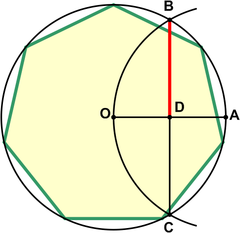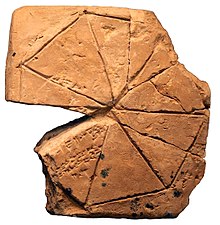Heptagon
| Regular heptagon | |
|---|---|
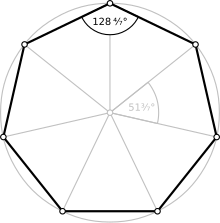 A regular heptagon | |
| Type | Regular polygon |
| Edgesandvertices | 7 |
| Schläfli symbol | {7} |
| Coxeter–Dynkin diagrams | |
| Symmetry group | Dihedral(D7), order 2×7 |
| Internal angle(degrees) | ≈128.571° |
| Properties | Convex,cyclic,equilateral,isogonal,isotoxal |
| Dual polygon | Self |
Ingeometry,aheptagonorseptagonis a seven-sidedpolygonor 7-gon.
The heptagon is sometimes referred to as theseptagon,using "sept-" (anelisionofseptua-,aLatin-derivednumerical prefix,rather thanhepta-,aGreek-derived numerical prefix; both are cognate) together with the Greek suffix "-agon" meaning angle.
Regular heptagon[edit]
Aregularheptagon,in which all sides and all angles are equal, hasinternal anglesof 5π/7radians(1284⁄7degrees). ItsSchläfli symbolis {7}.
Area[edit]
The area (A) of a regular heptagon of side lengthais given by:
This can be seen by subdividing the unit-sided heptagon into seven triangular "pie slices" withverticesat the center and at the heptagon's vertices, and then halving each triangle using theapothemas the common side. The apothem is half thecotangentofand the area of each of the 14 small triangles is one-fourth of the apothem.
The area of a regular heptagoninscribedin a circle ofradiusRiswhile the area of the circle itself isthus the regular heptagon fills approximately 0.8710 of its circumscribed circle.
Construction[edit]
As 7 is aPierpont primebut not aFermat prime,the regular heptagon is notconstructiblewithcompass and straightedgebut is constructible with a markedrulerand compass. It is the smallest regular polygon with this property. This type of construction is called aneusis construction.It is also constructible with compass, straightedge and angle trisector. The impossibility of straightedge and compass construction follows from the observation thatis a zero of theirreduciblecubicx3+x2− 2x− 1.Consequently, this polynomial is theminimal polynomialof2cos(2π⁄7),whereas the degree of the minimal polynomial for aconstructible numbermust be a power of 2.
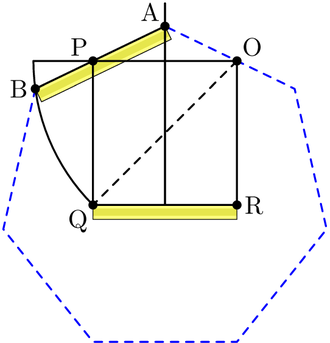 Aneusis constructionof the interior angle in a regular heptagon. |
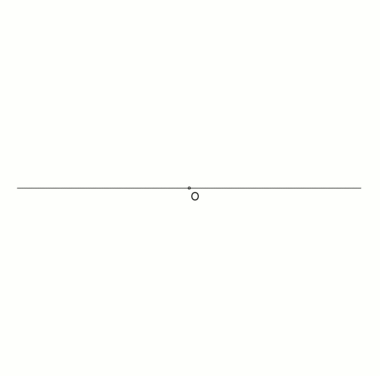 An animation from a neusis construction with radius of circumcircle,according toAndrew M. Gleason[1]based on theangle trisectionby means of thetomahawk.This construction relies on the fact that
|
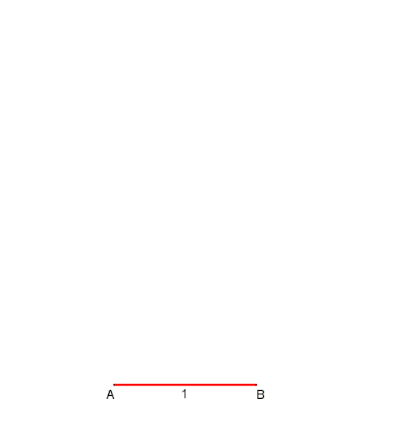
An animation from aneusis constructionwith marked ruler, according to David Johnson Leisk (Crockett Johnson).
Approximation[edit]
An approximation for practical use with an error of about 0.2% is to use half the side of an equilateral triangle inscribed in the same circle as the length of the side of a regular heptagon. It is unknown who first found this approximation, but it was mentioned byHeron of Alexandria'sMetricain the 1st century AD, was well known to medieval Islamic mathematicians, and can be found in the work ofAlbrecht Dürer.[2][3]LetAlie on the circumference of the circumcircle. Draw arcBOC.Thengives an approximation for the edge of the heptagon.
This approximation usesfor the side of the heptagon inscribed in the unit circle while the exact value is.
Example to illustrate the error:
At a circumscribed circle radiusr = 1 m,the absolute error of the 1st side would beapproximately -1.7 mm
Other approximations[edit]
There are other approximations of a heptagon using compass and straightedge, but they are time consuming to draw. [4]
Symmetry[edit]
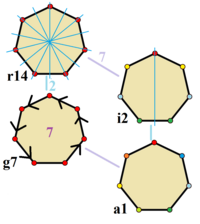
Theregular heptagonbelongs to theD7hpoint group(Schoenflies notation), order 28. The symmetry elements are: a 7-fold proper rotation axis C7,a 7-fold improper rotation axis, S7,7 vertical mirror planes, σv,7 2-fold rotation axes, C2,in the plane of the heptagon and a horizontal mirror plane, σh,also in the heptagon's plane.[6]
Diagonals and heptagonal triangle[edit]

The regular heptagon's sidea,shorterdiagonalb,and longer diagonalc,witha<b<c,satisfy[7]: Lemma 1
- (theoptic equation)
and hence
and[7]: Coro. 2
Thus –b/c,c/a,anda/ball satisfy thecubic equationHowever, noalgebraic expressionswith purely real terms exist for the solutions of this equation, because it is an example ofcasus irreducibilis.
The approximate lengths of the diagonals in terms of the side of the regular heptagon are given by
We also have[8]
and
Aheptagonal trianglehasverticescoinciding with the first, second, and fourth vertices of a regular heptagon (from an arbitrary starting vertex) and anglesandThus its sides coincide with one side and two particulardiagonalsof the regular heptagon.[7]
In polyhedra[edit]
Apart from theheptagonal prismandheptagonal antiprism,no convex polyhedron made entirely out of regular polygons contains a heptagon as a face.
Star heptagons[edit]
Two kinds of star heptagons (heptagrams) can be constructed from regular heptagons, labeled bySchläfli symbols{7/2}, and {7/3}, with thedivisorbeing the interval of connection.
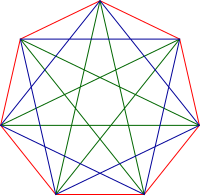
Blue, {7/2} and green {7/3} star heptagons inside a red heptagon.
Tiling and packing[edit]
A regular triangle, heptagon, and 42-gon can completelyfill a plane vertex.However, there is no tiling of the plane with only these polygons, because there is no way to fit one of them onto the third side of the triangle without leaving a gap or creating an overlap. In thehyperbolic plane,tilings by regular heptagons are possible. There are also concave heptagon tilings possible in the Euclidean plane.[9]

The regular heptagon has adouble latticepacking of the Euclidean plane of packing density approximately 0.89269. This has been conjectured to be the lowest density possible for the optimal double lattice packing density of any convex set, and more generally for the optimal packing density of any convex set.[10]
Empirical examples[edit]
The United Kingdom, since 1982, has two heptagonalcoins,the50pand20ppieces. TheBarbados Dollarare also heptagonal. Strictly, the shape of the coins is aReuleaux heptagon,acurvilinearheptagon which hascurves of constant width;the sides are curved outwards to allow the coins to roll smoothly when they are inserted into avending machine.Botswana pulacoins in the denominations of 2 Pula, 1 Pula, 50 Thebe and 5 Thebe are also shaped as equilateral-curve heptagons. Coins in the shape of Reuleaux heptagons are also in circulation in Mauritius, U.A.E., Tanzania, Samoa, Papua New Guinea, São Tomé and Príncipe, Haiti, Jamaica, Liberia, Ghana, the Gambia, Jordan, Jersey, Guernsey, Isle of Man, Gibraltar, Guyana, Solomon Islands, Falkland Islands and Saint Helena. The 1000Kwachacoin of Zambia is a true heptagon.
TheBrazilian25-cent coin has a heptagon inscribed in the coin's disk. Some old versions of thecoat of arms of Georgia,including inSoviet days,used a {7/2} heptagram as an element.
A number of coins, including the20 euro cent coin,have heptagonal symmetry in a shape called theSpanish flower.
In architecture, heptagonal floor plans are very rare. A remarkable example is theMausoleum of Prince ErnstinStadthagen,Germany.
Many police badges in the US have a {7/2} heptagram outline.
See also[edit]
References[edit]
- ^Gleason, Andrew Mattei (March 1988)."Angle trisection, the heptagon, and the triskaidecagon p. 186 (Fig.1) –187"(PDF).The American Mathematical Monthly.95(3): 185–194.doi:10.2307/2323624.JSTOR2323624.Archived fromthe original(PDF)on 19 December 2015.
- ^Hogendijk, Jan P. (1987)."Abu'l-Jūd's Answer to a Question of al-Bīrūnī Concerning the Regular Heptagon"(PDF).Annals of the New York Academy of Sciences.500(1): 175–183.doi:10.1111/j.1749-6632.1987.tb37202.x.
- ^G.H. Hughes,"The Polygons of Albrecht Dürer-1525, The Regular Heptagon", Fig. 11the side of the Heptagon (7) Fig. 15, image on the left side,retrieved on 4 December 2015
- ^raumannkidwai. "Heptagon." Chart. Geogebra. Accessed January 20, 2024. https://www.geogebra.org/classic/CvsudDWr.
- ^John H. Conway, Heidi Burgiel,Chaim Goodman-Strauss,(2008) The Symmetries of Things,ISBN978-1-56881-220-5(Chapter 20, Generalized Schaefli symbols, Types of symmetry of a polygon pp. 275-278)
- ^Salthouse, J.A; Ware, M.J. (1972).Point group character tables and related data.Cambridge: Cambridge University Press.ISBN0-521-08139-4.
- ^abcAbdilkadir Altintas, "Some Collinearities in the Heptagonal Triangle",Forum Geometricorum16, 2016, 249–256.http://forumgeom.fau.edu/FG2016volume16/FG201630.pdf
- ^Leon Bankoff and Jack Garfunkel, "The heptagonal triangle",Mathematics Magazine46 (1), January 1973, 7–19.
- ^Sycamore916, ed. "Heptagon." Polytope Wiki. Last modified November 2023. Accessed January 20, 2024.https://polytope.miraheze.org/wiki/Heptagon.
- ^Kallus, Yoav (2015). "Pessimal packing shapes".Geometry & Topology.19(1): 343–363.arXiv:1305.0289.doi:10.2140/gt.2015.19.343.MR3318753.
External links[edit]
- Definition and properties of a heptagonWith interactive animation
- Heptagon according Johnson
- Another approximate construction method
- Polygons – Heptagons
- Recently discovered and highly accurate approximation for the construction of a regular heptagon.
- Heptagon, an approximating construction as an animation
- A heptagon with a given side, an approximating construction as an animation
Heptagon











